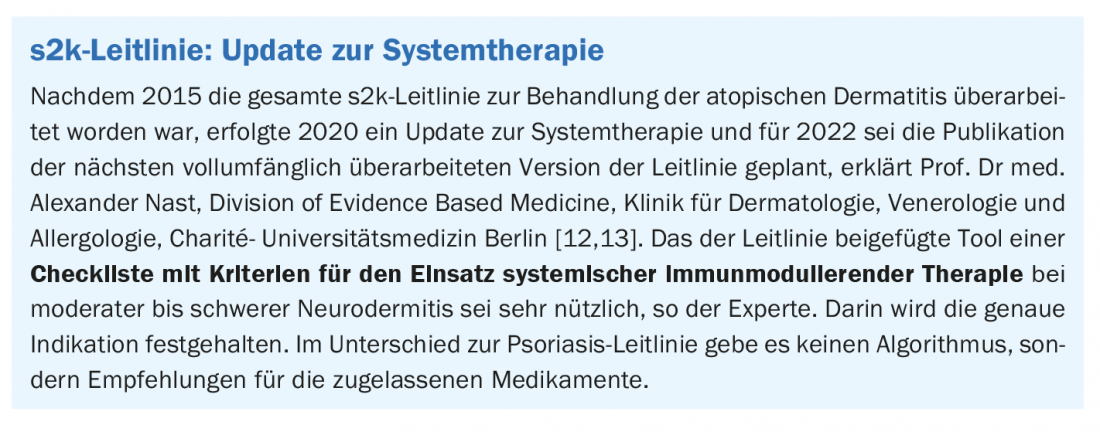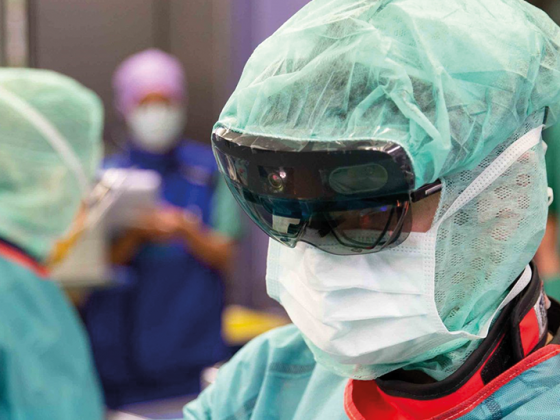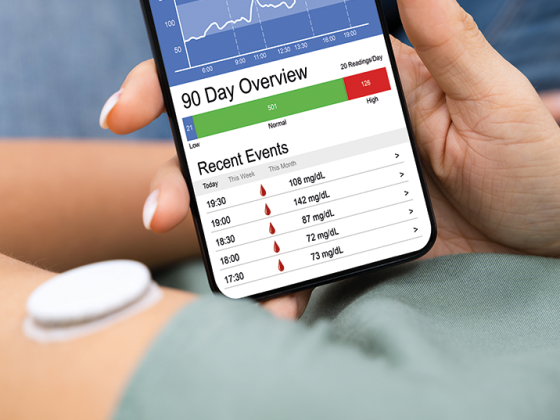In addition to the new systemic drugs recently launched, several active substances are currently in development. These include some biologics in advanced stages of clinical testing. Overall, the future prospects for the treatment of atopic dermatitis are extremely good. The goal is to further optimize treatment options and identify predictors for the best possible individual system therapy.
Renowned experts spoke about facts and trends in the field of atopic dermatitis at this year’s virtual DDG meeting. In summary, the situation with regard to the treatment of moderate to severe atopic dermatitis is already much better than before, and with regard to the future, further improvement is targeted, according to Prof. Thomas Werfel, MD, of the Department of Dermatology, Allergology and Venereology, Hannover Medical School [1]. In the spirit of personalized medicine, the aim is to provide the best possible patient care adapted to individual circumstances (overview 1). The most important pathogenetic factors in atopic dermatitis include Th2-mediated inflammation and an epidermal barrier defect. Thus, suppression of Th2 immunity is an important therapeutic principle. Microbial dysbiosis is also a relevant factor, explains Prof. Tilo Biedermann, MD, Clinic and Polyclinic for Dermatology and Allergology, TU Munich [2]. “The dominance of staphylococci on the skin can further aggravate and chronify the inflammation,” explains Prof. Biedermann. Microbial instability may be a target of future treatment options, he said.
Dupilumab receives the highest strength of recommendation in the current guideline
During the past years, the IL4/IL13 inhibitor Dupilumab (Dupixent®) has decisively shaped the system therapy of atopic dermatitis and has also been included in the treatment recommendations of the guidelines. In the update of the s2k guideline (box) there is a ‘may’ recommendation for dupilumab, for ciclosporin it says ‘may be considered’, i.e. a somewhat weaker recommendation, explains Prof. Werfel [1]. Long-term steroid therapy or omalizumab, on the other hand, are not recommended. Baricitinib is not included in the guideline update on systemic therapy because it was prepared prior to marketing approval of Olumiant®. Dupixent® is approved in both Switzerland and Germany for the treatment of moderate to severe atopic dermatitis in adults and adolescents 12 years of age and older who are eligible for systemic therapy. In contrast to Switzerland, Dupixent® can also be used in Germany in children aged 6 to 11 years for the indication atopic dermatitis. According to registry data, dupilumab is now the most commonly prescribed systemic treatment for moderate to severe atopic dermatitis.

Biologics in advanced clinical development: Targeting IL13 and IL31
Research into immunopathological mechanisms has shown that the cytokines IL4, IL13 and IL31 produced by Th2 cells are of central pathophysiological importance [3].In addition to dupilumab, there are several other promising drug candidates, including the two IL13 inhibitors tralokinumab and lebrikizumab, according to Prof. Diamant Thaci, MD, Institute and Center of Excellence, University of Lübeck [4]. Moreover, with the IL31 inhibitor nemolizumab, clinical research has another arrow in its quiver. Nemolizumab has proven to be very effective, especially in relieving itching, reports Prof. Thaci.

Tralokinumab: In both the 52-week randomized, double-blind, placebo-controlled phase III ECZTRA 1 (n=802) and ECZTRA 2 (n=794) studies, adults with moderate to severe atopic dermatitis were randomized (3:1) to tralokinumab 300 mg every 2 weeks (Q2W) or placebo. In the tralokinumab group, a significant improvement in IGA (Investigator Global Assessment) compared to placebo (p<0.001) was already achieved after 16 weeks [5–7]. This confirmed the good results of the phase IIb study, in which response rates of up to 70% for EASI50 and up to 40% for EASI75 were achieved in patients with moderate to severe atopic dermatitis [8].
Lebrikizumab: This novel IL13 inhibitor selectively prevents the formation of the IL-13Rα1/IL-4Rα heterodimer receptor signaling complex in adults with moderate to severe atopic dermatitis [9]. In a placebo-controlled phase IIb dose-finding study, a total of 280 patients with atopic dermatitis were randomized to one of three lebrikizumab arms (125 mg every 4 weeks, 250 mg every 4 weeks, or 250 mg every 2 weeks) or placebo [9]. In week 16 after baseline, a dose-dependent, statistically significant improvement in the percent change in the Eczema Area Severity Index (EASI) was observed in the lebrikizumab groups compared with placebo (EASI least squares mean, [SD]: 125 mg every 4 weeks (-62.3%) [37,3%], p=0,02), 250 mg every 4 weeks (-69.2% [38 .3%], p=0.002) and 250 mg every 2 weeks (-72.1%). [37,2%], p<0,001). With regard to itching, an improvement of at least 4 points was observed in 15.3% (9 of 59) in the high-dose lebrikizumab group as early as day 2; in the placebo group, this proportion was only 4.5% (2 of 44).
Nemolizumab: This drug candidate targets IL31. Both proof-of-concept trials and longer observations in Phase IIb demonstrated added value in the area of pruritus control [10]. In a 16-week randomized trial published in the New England Journal of Medicine in 2020, participants were randomized to receive either subcutaneous nemolizumab or placebo in a 2:1 ratio (143 and 72 patients, respectively) with concomitant topical agents [11]. Mean percent change in visual analog scale (VAS) score for pruritus was the primary endpoint. At week 16, mean percentage changes in VAS score were -42.8% in the nemolizumab group versus -21.4% in the placebo group (difference: 21.5 percentage points). Nemolizumab is also currently being evaluated for other indications.
Congress: DDG Conference 2021
Literature:
- Werfel T: Good (and already much better from before!): Management of moderate to severe atopic dermatitis today, Prof. Thomas Werfel, MD, PV04: Plenary Lectures 4, DDG Conference 2021, 16.04.2021.
- Biedermann T: In Dialog: Good is not good enough – Management of atopic dermatitis, Here: “Not good enough!”, Prof. Dr. med. Tilo Biedermann, PV04: Plenary lectures 4, Plenary lectures 4, DDG Conference 2021, 16.04.2021.
- Bieber T, et al: Novel therapies based on the pathophysiology of atopic dermatitis. JDDG 2019 17; 11: 1150-1163.
- Biologics through the ages – therapeutic approaches yesterday, today and tomorrow. Prof. Dr. med. Diamant Thaci, S09: Track Inflammations: Atopic dermatitis and psoriasis as systemic diseases. DDG Meeting 2021, 17.04.2021.
- Wollenberg A: Tralokinumab for moderate-to-severe atopic dermatitis: results from two 52-week, randomized, double-blind, multicentre, placebo-controlled phase III trials (ECZTRA 1 and ECZTRA 2). British Journal of Dermatology 2021; 184(3): 437-449.
- Clinicaltrials.gov, https://clinicaltrials.gov/ct2/show/NCT03131648
- Clinicaltrials.gov, www.clinicaltrials.gov/ct2/show/NCT03160885
- Wollenberg A, et al: Treatment of atopic dermatitis with tralokinumab, an anti-IL 13mAb. J Allergy Clin Immunol 2019; 143(1): 135-141.
- Guttman-Yassky E, et al: Efficacy and Safety of Lebrikizumab, a High-Affinity Interleukin 13 Inhibitor, in Adults With Moderate to Severe Atopic Dermatitis: A Phase 2b Randomized Clinical Trial. JAMA Dermatol 2020; 156(4):411-420.
- Ruzicka T, et al. Anti-interleukin-31 receptor A antibody for atopic dermatitis. N Engl J Med 2017; 376: 826-835.
- Kabashima K, et al. Trial of Nemolizumab and Topical Agents for Atopic Dermatitis with Pruritus. N Engl J Med 2020; 383: 141-150.
- Nast A: New and old guiding(d) lines in PsO and AD, Prof. Alexander Nast, MD, S09: Track Inflammation: Atopic dermatitis and psoriasis as systemic diseases. DDG Meeting 2021, 17.04.2021.
- Werfel T, et al: System therapy for atopic dermatitis. Update to the s2k guideline neurodermatitis. JDDG 2021; 19(1): 151-169.
DERMATOLOGIE PRAXIS 2021; 31(3): 18-19 (published 5/31/21, ahead of print).











